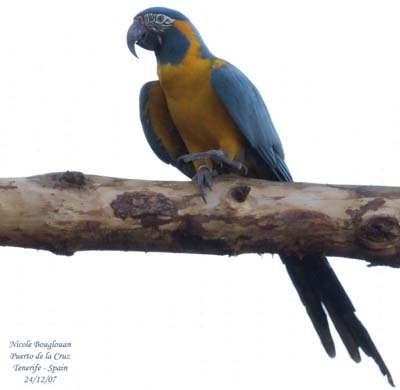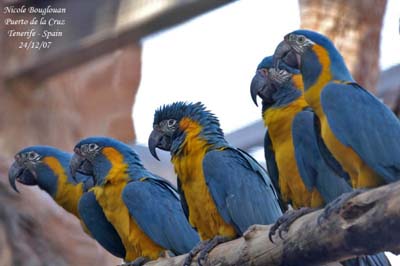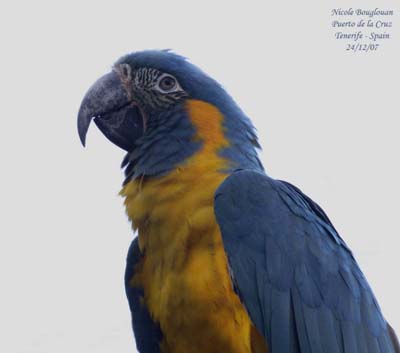
Blue-throated Macaw
Ara glaucogularis
Psittaciforme Order - Psittacidae Family
BIOMETRICS:
Length: 85 cm; Wingspan: 90 à 100 cm; Weight: 600 à 800 gr.
LONGEVITY: up to 80 years
DESCRIPTION:
Blue-throated Macaw is endemic to a small region named Llanos de Moxos, in north-centre Bolivia. This species is endangered.

Blue-throated Macaw has blue upper parts, lighter than in the Blue and Yellow Macaw (Ara ararauna). Wings are slightly darker blue.
Underparts are bright yellow, except undertail coverts which are blue. Under tail feathers are rather orange. Under wing is yellow with darker flight feathers.
On the head, forehead, crown, nape, chin and throat are greenish-blue. We can see a yellow band between nape and throat, coming from ear-coverts and joining the yellow breast.
Bare face is white with greenish-blue feathered lines. Cere is white too.
Strong bill is blackish. Eyes are pale yellow. Legs and feet are dark grey.
Both sexes are similar.
Juvenile resembles adults, with darker blue throat, grey eyes and shorter tail. It reaches its sexual maturity at 2-4 years.
VOICE: SOUNDS BY XENO-CANTO
Blue-throated Macaw utters similar calls to those of the Blue and Yellow Macaw, such as “rraa-aaar”, loud and guttural, but these sounds are softer and higher-pitched. It gives loud, raucous calls when alarmed.
HABITAT:
Blue-throated Macaw lives mainly in elevated, dry thickets of palm trees (Attalea phalerata), located in seasonally flooded lowlands. It also can be found in savannahs and gallery woodlands along streams. It is visible up to 300 metres of elevation.
RANGE:
Blue-throated Macaw is found in Bolivia, in a small area named El Beni, in the Centre-north.
BEHAVIOUR:
Blue-throated Macaw is usually seen in pairs or in small groups, and it can be seen with other species such as Blue and Yellow Macaws. Both are very similar and can frequent the same nigh-time roosts.

Blue-throated Macaw is an arboreal parrot. It feeds mainly on fruits of Attalea and Acronomia palms. It may open unripe nuts, in order to reach the liquid within.
As other parrots, it needs to clean its beak, and for that, it regularly comes to Tabebuia trees where it causes some damages to the branches with its hard beak.
Blue-throated Macaws breed easily in captivity, but in the wild, they often compete over nesting cavities with other species, and its smaller size makes it often disadvantaged.
Blue-throated Macaws are monogamous and mate for life. When the pair flies within a flock, both mates fly close to each other, with wings nearly touching.
FLIGHT:
Blue-throated Macaw has direct flight with shallow wing beats, and it can reach speeds of up to 55 km per hour.
REPRODUCTION:
Breeding season occurs from October-November to March.
Blue-throated Macaw nests in holes in large trees, mainly in palm trees.
In captivity, they can become aggressive during the nesting period.
Female lays 2 to 3 eggs. Incubation lasts about 4 weeks. Chicks remain with adults for about three months before to fledge.
This species can breed twice in a year.
DIET:
Blue-throated Macaw feeds on the fruits of palms (Attalea and Acromonia).

PROTECTION / THREATS / STATUS:
Blue-throated Macaw is heavily threatened by cage-bird trade and loss of nest-sites and food resources.
This species has very restricted range, which makes vulnerable the populations of this macaw. However, thanks to conservation programs in Bolivia, numbers have slightly increased in 2007.
Fr: Ara canindé
All : Blaukehlara
Esp : Guacamayo Barbazul
Ital : Ara di Wagler
Nd : Blauwkeelara
Photographs and text by Nicole Bouglouan
Sources:
HANDBOOK OF THE BIRDS OF THE WORLD vol 4 by Josep del Hoyo-Andrew Elliott-Jordi Sargatal - Lynx Edicions - ISBN: 8487334229
PARROTS OF THE WORLD – An Identification Guide – by Joseph M. Forshaw – Princeton University Press – ISBN 0691092516
BirdLife International (BirdLife International)
Wikipedia (Wikipedia, The Free Encyclopedia)